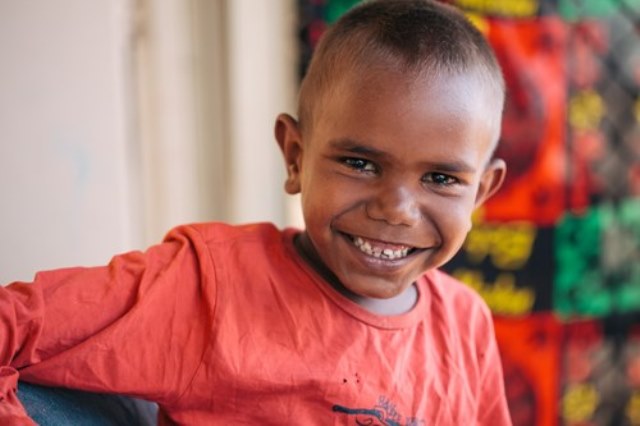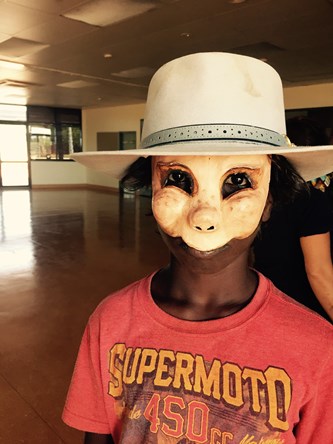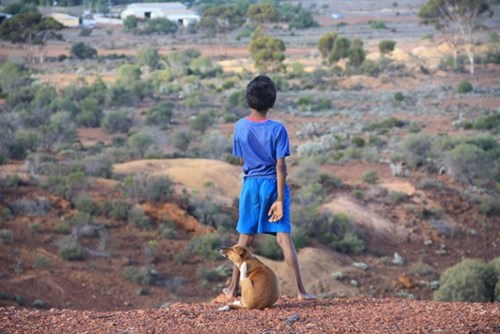“We need to focus on the youth, they are our future…” 17 year-old Nyikina young person, Kimberley region
Stage 3 - Doing it – Involving Aboriginal children and young people

This stage requires you to think about your communication and continue to test your processes as you begin to actively engage with Aboriginal children and young people.
Stage 3 has seven steps:
Step 1: Communication - be genuine and clear
Step 3: Recruiting Aboriginal children and young people to participate
Step 5: Working together - involving the community
Step 1
Communication - be genuine and clear
“White people they will just…they don’t care. They just look at us and say nothing to us. They just walk away and have no respect for us… When we speak our language or anything like that, or when we talk, they just look at us and laugh and copy us and then make fun of us.” 15 year-old young person
The engagement and participation methods your organisation or agency chooses need to be appropriate to the age, background, interests and capabilities of the Aboriginal children and young people you wish to involve. Adopt a strengths-based perspective that builds and develops the existing strengths, skills and capacities of Aboriginal children and young people.
The successful participation of Aboriginal children and young people depends on genuine and effective communication. You need to clearly tell young people:
- who you are
- what you are trying to achieve
- how you plan to achieve it
- what role children and young people will play
- where, when and how you will be engaging with them (time frame and commitment required)
- why you are engaging with them both generally as children and young people and that specific target group
- how you will check back with them to ensure that you’ve heard, and will share, their views accurately
- who will see/hear their contributions and what will be done with them.
Step 2
Test your process
“The most important thing in my culture is to be a good role model, stand up for what’s right, stick up and protect family and be proud of myself.” 13 year-old young person, Pilbara
It is useful to test your communication resources and activity/service on an identified group of children and young people who can provide feedback to you prior to launching and implementing your project. This group may be identified through:
- your consultations with the community
- your consultations with stakeholders
- previously engaged Aboriginal children and young people
- students from the local school
- a targeted recruitment process for your project (as outlined below).
This will help to ensure your resources are clear, understood by and effective with your target audience.
Step 3
Recruiting Aboriginal children and young people to participate
“I would change a lot of things in my community if I was a boss like having more role models for the younger kids to teach them right from wrong and have respect and to encourage kids to get to school ‘cause learning is very important in life.” 11 year-old child, Goldfields-Esperance
Aboriginal children and young people tell us that they want to be role models for other members of their community, particularly those younger than them. In the initial stages of seeking to engage with Aboriginal children and young people, you may need to use multiple forms of communication (including local language(s) if appropriate) to reach them. These communications may target families as well as children and young people directly by:
- word of mouth – utilise existing service providers and other key stakeholders and their established relationships and communication systems
- local radio, television and newspapers
- social media, including community social media (for example the Everything Geraldton account/page)
- promotion in community and sporting groups, cultural spaces, schools and youth centres
- local community boards, including at the local shopping centre.
Step 4
Implementing consent
“My parents thought it was important that I build a future for myself so encouraged me to go. I’m glad they did.” 18 year-old young person, Perth
Children and young people must provide their consent to be involved in an activity; what this looks like will depend on the protocol you have agreed with the community in your earlier consultations.
Remember that children and young people can withdraw their consent at any time, even once they have started the activity, this is another reason that participants/contributors will need to be kept informed as throughout the different stages of the project or activity. You will also need to specifically obtain consent to take and use photographs, and for the use of the information gained through the participation activity. Always be clear about what the information will be used for. Below is an example of a consent form:
Sample consent form - Commissioner for Children and Young People WA
In some communities Aboriginal young people may be considered adult by the community, having been through ‘lore’ ceremony/process, and consequently able to give their own consent.25 It is important to consult with Aboriginal Elders and leaders in the community to seek their advice on this.
In most cases it will be necessary to obtain the consent of the child or young person’s parent or guardian too. Consider your organisation’s/agency's duty of care and its processes around obtaining parental consent. At times, it may be difficult to obtain consent from parents or guardians of certain children and you will need to plan and set out the process you will follow when this occurs. Remember that the parents and guardians of the children and young people you are working with are important stakeholders and the appropriate time and effort needs to be allocated to ensuring they understand what you are doing with their children and young people.
Particularly in regional and remote communities, the practice of obtaining consent may involve a combination of visiting families door-to–door and organising family friendly community events (such as a BBQ), which provide opportunities for you to speak with parents and guardians about your organisation or agency, seek their feedback on your proposed activities and, ultimately, obtain their informed permission and consent to work with their children and young people.
Don’t forget to bring additional consent forms with you on the day of the activity to ensure all participants have a signed consent form and are familiar with the terms of participation on the day.
For more information about consent, see the Commissioner for Children and Young people's consent and participation policies on the Understanding participation page.
Step 5
Working together - involving the community
“Family keeps you safe, we have a culture of sharing.” 7 year-old child, Perth
Where possible, this should be done through direct feedback from the children and young people themselves, who can help shape the information provided back to community and develop their own communication and leadership skills in the process.
At what stage of the project/service community participation takes place and what it looks like will depend on what is appropriate in the context you are operating in and what you have agreed with the community. For example it may include a high level of involvement in the development and implementation of your project or service from the outset, or it may be limited to feedback following engagement with children and young people.
Participation by community stakeholders allows for valuable relationship development and information sharing between key stakeholders and supports children and young people, community members and service providers to work together, respectfully and in an integrated way, to develop solutions for the challenges in their own community.26
Through involvement, either by active participation or in receiving feedback, community members and service providers are more likely to feel motivated and empowered to enable the children and young people’s vision.
Case study extract
Theatre of Transformation Project – Project partners
The Theatre of Transformation Project is an excellent example of a partnership between different community sectors to achieve a common goal.
“The Theatre of Transformation Project was a community-based activity conducted in Halls Creek by the following project partners:
- Kimberley Community Drug and Alcohol Service (KCADS)
- Melbourne based theatre director, Bryan Derrick
- the local Aboriginal Medical Service, Yura Yungi
- Halls Creek High School.”
View the Theatre of Transformation Project case study

Step 6
Methods and activities
“Always know that children and young people are looking for someone who will really listen. Keep youth projects fun with a positive outcome for them, and listen.” Kennah Parker27
Involve Aboriginal children and young people in choosing the methods and activities they prefer and ask them how they would like to be communicated with.
Enable Aboriginal children and young people to determine their own priorities both during the development of, and within the context of, your participation activity, and to develop their own problem solving approach, and to decide on how they will contribute their views.
General ideas include:
- asking children and young people to help plan activities
- using creative, engaging and fun activities (for example, that include sport, arts and crafts and cooking)
- using mediums they value, such as online tools, music or videos and social media platforms (where appropriate)
- opportunities for local ‘doing’ activities such as going out bush, camping and fishing (particularly in remote and regional areas)
- using trusted Aboriginal community members and mentors to facilitate discussions
- upskilling young people to peer-to-peer facilitate discussions and mentor other children and young people
- encouraging and training young people to be co-facilitators
- selecting child and young person friendly venues and facilities, such as recreation centres and youth hubs – children and young people can offer good suggestions on this
- scheduling plenty of breaks and variation in activities.
For more examples of a range of participation activities see the Case Studies section of the toolkit.
Case study extract
Kids on Country – local ‘doing’ activities
Kids on Country is an activities based program that engages young people by taking then out on Country to complete various science related tasks.
“The program was developed through conversations with Aboriginal children and young people held around a fire, starting from the first day-trip. As the facilitators, Millenium Kids (MK) arranged food and logistics and asked simple, open questions to determine the priorities of the young people involved: What do you like about your community, what don’t you like and what would you change?”
View the Kids on Country case study

Step 7
Implementing participation
“Being a role model to the younger ones is important to me.” 15 year-old young person, Pilbara
Children and young people need to have fun, find the experience meaningful and benefit from it. Aboriginal children and young people like to take part in participation activities that:
- are challenging but achievable
- are meaningful
- are socially and culturally respectful
- build knowledge and confidence
- develop leadership skills
- make a difference
- take them seriously and treat them with respect.
Being taken seriously
Children and young people told us how they knew that they were being taken seriously:28
“They listen to you and don’t ignore you.”
“They are paying attention.”
“They acknowledge you.”
“They look at you.”
“[They] take your phone number.”
“[They] say they’ll get back to you.”
“They listen, are understanding and respectful.”
Practical tips for implementation on the day - Commissioner for Children and Young People
After the participation activity:
- recognise the participants and celebrate their achievement through stickers, certificates, accreditation or references (where appropriate)
- reward them with vouchers, products, publications or similar
- acknowledge their contributions in publications.
Go to Stage 4 - Following up with Aboriginal children and young people
Explore the toolkit
References
25. Vicary D, Tennant J, Garvie T and Adupa C 2008, Can You Hear Me? The Active Engagement of Aboriginal Children in the Development of Social Policy by Non-Aboriginals. Perth, Western Australian Office for Children and Youth.
26. The Australian Centre for Social Innovation 2013, Enabling change with Aboriginal families and services: A frank look at challenges & opportunities. Adelaide, South Australia: Australian Centre for Social Innovation, viewed 19 December 2017, <http://www.tacsi.org.au/project/report-enabling-change-with-aboriginal-families-and-services/>.
27. Commissioner for Children and Young People WA 2008, Young People’s Panel, Children’s Week Forum 2008: Making a positive difference in the lives of WA children, Commissioner for Children and Young People WA.
28. Commissioner for Children and Young People WA 2013, Are you listening? Guidelines for making complaints systems accessible and responsive to children and young people, Commissioner for Children and Young People WA, Perth.



